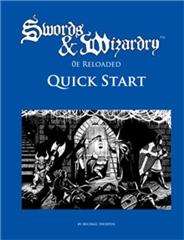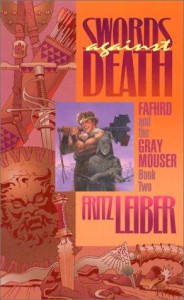Swords And Wizardry Appreciation Day: Heroic Dueling
 To celebrate the official Swords & Wizardry Appreciation Day April 17th I thought I’d share some combat rules I’ve been experimenting with, intended for use with the Swords & Wizardry based game Crypts & Things. If you’re new to the site, welcome. If you’re a regular visitor who’s not a gamer, be warned — your eyes are likely to glaze over if you try to read further.
To celebrate the official Swords & Wizardry Appreciation Day April 17th I thought I’d share some combat rules I’ve been experimenting with, intended for use with the Swords & Wizardry based game Crypts & Things. If you’re new to the site, welcome. If you’re a regular visitor who’s not a gamer, be warned — your eyes are likely to glaze over if you try to read further.
If you’re a regular visitor who games I hope you’ll follow this link to check out essays about Swords & Wizardry, not to mention some sales and giveaway contests.
Heroic Dueling
These rules are designed for those climatic moments when the hero faces off against the big bad – so long as that villain is more or less human sized and wielding weapons.
 Over the years I’ve grown more and more disappointed about how these moments play out in various old school renaissance games because they often turn into boring back and forth rolls against armor class while the characters wear down one another’s hit points. I’m equally bored by more complex modern games and their elaborate feat trees, which still don’t get me what I’m after. I want an actual exchange of blows, dodges, shield blocks and clever tactics. Inspired by some of the rules I found in Crypts & Things and from good old Chainmail, I decided to experiment with some systems to make these combats more vivid.
Over the years I’ve grown more and more disappointed about how these moments play out in various old school renaissance games because they often turn into boring back and forth rolls against armor class while the characters wear down one another’s hit points. I’m equally bored by more complex modern games and their elaborate feat trees, which still don’t get me what I’m after. I want an actual exchange of blows, dodges, shield blocks and clever tactics. Inspired by some of the rules I found in Crypts & Things and from good old Chainmail, I decided to experiment with some systems to make these combats more vivid.
I hope it goes without saying that if you don’t like the idea of these rules, or a mini-game inside combat, I understand. I don’t mean to suggest that “you’re playing it wrong.” This rule set makes me a little happier and I’m offering a rough draft to any interested parties on the chance that some of you might enjoy it as well.
The rules are intended for use in mid to high-level OSR games, for fighters. And they really are intended only for those one on one (or two on one) combat scenes. To use them in every instance of combat would make combat monotonous and overly detailed, and if you’ve a party of more than three or four characters everyone would be bored watching this stuff play out if it happened every time
 I’ve just gotten the rules working with one on one battles using swords, or swords and shields. I’ve yet to really experiment with dual swords or multiple opponents. If there’s interest I’ll keep developing. Of course I’m open to feedback. I’ve received some excellent suggestions from Kevin Crawford of Sine Nomine that might help streamline the process further, but I haven’t had time to play test them, so I’m sharing what I have.
I’ve just gotten the rules working with one on one battles using swords, or swords and shields. I’ve yet to really experiment with dual swords or multiple opponents. If there’s interest I’ll keep developing. Of course I’m open to feedback. I’ve received some excellent suggestions from Kevin Crawford of Sine Nomine that might help streamline the process further, but I haven’t had time to play test them, so I’m sharing what I have.
I built the rules over some existing Swords & Wizardry numbers, but I’ve changed some rules from regular combat as well, as you’ll see. If you’re using Weapons Mastery and Weapons Grand Mastery rules from Crypts & Things and your fighter routinely fights with sword and shield, assume for the ease of play that the chance to hit with both sword and shield is the same number because you practice with both all the time.
After the rules I’ve got an example of play to show them in action.
The Basic Rules
-
The usual number of attacks per round rules DO NOT APPLY. They are replaced by Combat Points. No matter what level your fighter is, your attacks per round are determined by Combat Points.
- Combatants alternate spending Combat Points to maneuver or Attack.
Every 5 second round, both attacker and defender get:
- All their Combat Points (explained below).
- 1 free Strike OR Parry.
- Combatant armed with a shield get 1 free Shield Block
- Combatant armed with a parrying dagger get 1 free Parry and a +2 to Bind attempts. (Some swords and weapons, obviously, can’t be affected by a parrying dagger.)
Initiative
- Roll initiative on D6. The combatants can spend up to 3 Combat Points to push initiative in their favor, including any (up to 3 total) they had left over at the end of the last round.
- There are no Dex bonuses to initiative unless the combatant has 18 (+1) or the monster/opponent is lightning-fast, in which case the GM assigns an initiative bonus ranging from +1 to +3. (+2 or +3 should be reserved for some incredibly swift foe! +1 is bad enough.)
- A result of the same initiative number from both sides means combatants move at the same time: if both combatants Attack without trying to Shield Block or Parry, they both may hit!
- The combatant who wins initiative has momentum and drives the action until he or she misses, get Sidestepped, Blocked, Riposted, or runs out of Combat Points.
If a combatant chooses to take their first maneuver to Recover, the other combatant steals initiative.
Attacking
 Regular to-hit and armor class numbers are used, even though they’re meant as an aid for the more abstract version of combat. (I wanted to avoid creating another OSR statistic.) As shields are actually used in this system, I advise against adding them into Armor Class calculations – although if you’ve added them in, removing them may require enough hassle that you won’t want to bother.
Regular to-hit and armor class numbers are used, even though they’re meant as an aid for the more abstract version of combat. (I wanted to avoid creating another OSR statistic.) As shields are actually used in this system, I advise against adding them into Armor Class calculations – although if you’ve added them in, removing them may require enough hassle that you won’t want to bother.
Once a combatant rolls a successful Attack it may not necessarily be a hit – it’s just a really strong blow. The defender, so long as he or she has a free Shield Block or Parry, or Combat Points remaining to spend on Block, Parry, Sidestep, or other maneuver, may be able to avoid any blow that’s not a critical. A defender out of all of those things takes the damage as usual.
When it’s a combatant’s turn to maneuver and he or she is on the attack, Offensive Maneuver Actions can stack with Attacks so long as the requisite Combat Points are available – Knocking and Attacking, Distracting and Attacking, Attacking and Lunging, Feinting and Attacking, etc. Note that some of those Maneuver are one roll (Attacking and Lunging and Feinting and Attacking) and some are two, like Distracting and Attacking and Knocking and Attacking, depending in some part upon how the GM and player envision the actions.
- Criticals occur on a natural 20. Criticals don’t do extra damage; they mean the coming blow cannot be Parried, Sidestepped, or Blocked, and they bypass armor.
- Fumbles must be confirmed (a 1, then another 1). Characters from sword-and-sorcery novels, and their opponents, just don’t fumble very often, if ever. Usually, then, a 1 is a simple miss.
 Defending
Defending
A combatant Blocking or Knocking with a shield can immediately continue with an Attack so long as they have a free Attack or Combat Points remaining that allow it.
A defender who Parries has used his or her action and then it is the other combatant’s turn once more UNLESS the defender has enough Combat Points to stack a maneuver with the Parry. A combatant parrying with a sword must spend points to Riposte, Bind, Sidestep, or Disarm to steal initiative and Attack – if they’re trying to defend. If they just want to take the damage and NOT parry, they can, which would also leave the defender free to respond so long as he or she is still alive!
A defender can stack Maneuver Actions: Retreat and Avoid, say, or he or she can take the offensive with a successful Shield Block or Knock plus Attack. Or, if the combatant is shieldless, instead of trying to Parry, he or she could Sidestep.
 Damage
Damage
Damage is taken straight to Constitution. Taking it to Hit Points would prolong dueling to the point of monotony. To keep things simple, armor protects per the bonus it usually gives to armor class, so, for instance, ring mail absorbs 3 points of damage. Shields don’t absorb damage in this system since they’re used directly to block.
A hit location table could be used if you want to get more complicated.
Using armor twice – to calculate the armor class as well as to protect — may seem like double-dipping, but, again, recalculating to-hit numbers every time there’s a duel is just asking too much. This is supposed to be a fun alternate system, not a new way to increase book keeping. Humans taking damage straight to Con really should be able to have armor absorb some of the damage or they’ll go down fast against fell beasts of chaos and blood-thirsty bandit chieftains.
 Calculating Opponent Con Scores
Calculating Opponent Con Scores
Monsters and many adversaries don’t routinely have Constitution scores, so here’s a quick way to wing it. They get one point for each Hit Die, and then determine the rest by size and toughness. Smallish (8); Human sized (12) Larger (16). If they’re especially strong or robust add in another 2-4 points, keeping in mind that their Constitution points shouldn’t be too much higher than a hero’s. This system isn’t about beating away points until they’re gone, but about out maneuvering and out fighting.
If the opponent has a tough hide, assign them 1-3 extra armor points, remembering that even a little is a lot in this mini-system, and if they wear armor, apply as discussed, previously, with the AC bonus equaling the protection value of the armor.
So, for example, suppose we have a 5HD Fell Beast of Chaos. It’s got the head of a deer with empty eye sockets that burn with silver flame, but it’s human sized, so it’s a 12. It’s not any more robust than a normal human, and it doesn’t have a tough hide, so its Constitution points are 12+5 or 17.
It’s legs are clothed in stinking black furs and its chest is bare, so there’s no need to calculate armor.
 Combat Maneuvers
Combat Maneuvers
Combat Maneuvers are activated by the expenditure of Combat Points, which reset at the end of every round (which are of 5 second duration). As soon as a round is over, assuming that the combatant lives, the points reset. Combat Points unused at the end of a round can be spent to add a bonus to the initiative roll of the coming round (well, up to 3 of them). They can NOT be stockpiled to use the next round EXCEPT to help with initiative.
Combatants receive 1 Combat Point per hit die up until level 10. Afterward, they get one Combat Point per five levels. So every round an 8th level fighter armed with a sword and shield gets one free Strike (or Parry), one free Shield Block, and 8 Combat Points. A fell beast of chaos with 5HD armed with a sword and shield gets one free Strike (or Parry), one free Shield Block, and 5 Combat Points every round. A 20th level Fighter armed with a sword would get one free Strike (or Parry) and 12 Combat Points every round.
To use a Combat Maneuver is as simple as rolling the regular to-hit die against the opponent’s armor class, using the indicated modifiers in the Description column of the Defense or Attack Maneuver charts. A success indicates that the maneuver may have been effective, although the opponent can try to counter.
To defend against a Combat Maneuver usually requires expenditure of a Combat Point (unless the combatant is using the round’s free Shield Block, or Parry). After spending that Combat Point(s), the defender must then roll higher than the attacker with his or her own to-hit roll, applying modifiers as indicated in the Description column of the Attack Maneuvers Chart or Defense Maneuvers Chart, for example, adding in a defense bonus for variously sized shields. (Not equal to, but higher.) A success means that the attacker’s action failed. In some instances (Avoiding a Feint or Bind) the initiative may well switch to the defender, although the GM should be final arbiter.
Some Maneuvers require a slightly different mechanic, explained in the description.
Pardon the terrible chart formatting — I couldn’t figure out how to make the danged tables work in WordPress.
Attack Maneuver Chart
Combat Maneuver…..Point Cost………………Description
Attack……………………….. 5……………………….Additional attack after the free one.
Bind……………………………1……………………….Locks up enemy weapon so they can’t strike without expending Recover point. Successful Bind gives a +2 to Disarm.
Disarm………………………..4……………………….-4 to roll. Bonuses stack with this maneuver, so if opponent is distracted and their sword is Bound, then attacker gets +4.
Distract……………………….2………………………..Success means that defender is at -2 for rest of round, or, if Distract comes at end of the round, until they spend a Combat Point to Recover.
Feint……………………………1………………………..Opponent must roll higher to detect. Success means opponent can’t Shield Block or Parry incoming Attack!
Knock…………………………..2……………………….Successful Knock slams shield (or sword) into blade to knock it aside (or moves it out of the way with parrying dagger, cloak, etc.). Success gives +2 to hit on Attack if it immediately follows, even if it is the next round. Those effected by Knock must Recover.
Lunge…………………………..3 + Attack………….. Stacked with regular Attack and doubles damage before bonus. Reduces attacker combatant’s AC to 10 during opponent combatant’s next action and any maneuver tried before spending a Combat Point to Recover occurs at a -2.
Maneuver Opponent……..3……………………….Advance with flurry of blows to force opponent to expose flank to ally, to move them closer to an edge, etc. Success does not inflict damage.
Minor Attack………………..2……………………….Roll as regular Attack, 1-4 damage. Kick, punch, strike with pommel, shield bash, etc. Alternatively, the minor attack impedes balance with a trip or something similar, providing a +2 to the attacker’s next Attack until defender can spend a Combat Point to Recover.
Riposte………………………..1 (+ Attack)………..Combatant steals initiative and, so long as he or she still has their free Attack or Combat Points to make a new one, they can take the offensive. Note that Wait gives a free Riposte if combatant has successfully parried.
Defense Maneuver Chart
Combat Maneuver……Point Cost……………….Description
Avoid…………………………..1………………………..A success negates Bind and Knock attempts and detects a Feint.
Parry……………………………1……………………….Success grants a +1 to an immediate Disarm attempt. (A critical success enables a free Riposte.)
Recover………………………..1………………………..Combatant recovers equilibrium, backs up, adjusts stance, etc. so as to suffer no minuses. Can stack with Retreat.
Retreat…………………………2……………………….A fighting retreat, so long as the defender has room. Enemy combatant attacks at -2 until enemy combatant uses Recover – which in this case means they close the distance. Note that if combatant who’s retreating wants to reverse and Attack, he or she must spend a point to Recover as well, not to mention points for Attack.
Shield Block………………….1……………………….Raising shield to block an attack, adding in a bonus to their roll of +2 for little shield, +4 for med shield, +6 for large shield. Success blocks attack.
Sidestep………………………..2……………………….A skilled warrior can simply try to step aside to avoid the attack. 18 Dex add +1 to attempt. Failure incurs +2 damage.
Wait……………………………..1………………………..Watch other opponent, get +2 on next roll (Parry etc.). Two opponents waiting cancel each other’s bonus out – somebody has to act! A successful Wait gets a free Riposte.
 Additional Clarifications
Additional Clarifications
Combat Point effects are usually over at the end of the round, excepting the following, if they occur as the last action of the round:
- A Wait gives the combatant a +2 to initiative rather than the +2 to the next roll as per usual.
- A successful Distraction as the last action of the round gives the effected combatant a -2 on all rolls throughout the coming round, until they spend a Combat Point to Recover, including initiative.
- A successful Knock carries over into the next round until the affected combatant spends a point to Recover.
- A Retreat means the distance has been opened up. An attacker or defender can close the distance by spending a Recover point (in this instance Recover means it would be closing the distance — why bother creating another category and complicating things further?)
Example of Play
Koll, Slayer of Beasts, and his friend Kalina have just defeated the undead minions of Andrath the wizard. The wizard has fled through a curtain. As Koll races forward, the fabric parts and out steps a man-high beast with a deer’s head holding a black shield and a sword with a curved tip. Where its eyes should be are silvery flames matched by the eerie fire racing along the edge of its blade.
GM: The fell beast brandishes its sword, laughing in a high, warbling voice. “Die, man-thing!”
Koll: The beast is mine!
Koll is 8th level, which means he has 8 Combat Points. His Armor Class is 16 and he needs a 9 to hit the Fell Beast. His Constitution is 16. Constitution rather than Hit Points is used for heroic duels, as explained above — along with how to calculate Constitution scores for creatures that don’t normally have them listed. His sword does 1d8 +1, +2 damage due to Koll’s strength, for a total of +3.
The Fell Beast has 5 HD, which means it has 5 Combat Points. It has an AC of 16 and needs an 11 to hit Koll. It has 17 Constitution points (explained above). It’s sword does 1d8+2 — it gets an extra point for its unholy flame.
Both combatants are armed with sword and shield, mostly so you can see how much of an advantage a fighter armed with a shield and sword would have over someone just carrying a sword. It’s a lot easier to fend off blows!
Round 1
The GM and Koll’s player roll initiative. Neither the Fell Beast nor Koll has a Dex or speed bonus and neither spend Combat Points to improve initiative, so there are no modifiers to either roll. The Fell Beast rolls a 3 and Koll gets a 2 — the beast wins initiative and swings its flickering sword expertly — a 19, with modifiers.
GM: It’s a solid blow!
Koll: I bring up my shield. (This is his free Shield Block for the round. He rolls a 12. With his modifiers to hit, including the +4 for using a medium shield, he just barely takes the blow by rolling higher than the attack.)
GM: The sword clangs dully off your shield.
Because you can stack Shield Block with Attack, this is exactly what Koll does.
Koll: I glower and swing for his vitals. (With modifiers he gets a 20.)
GM: A mighty blow! The beast tries to bring its own shield in line… (and with a 14, plus 4 for his shield, plus 5 for its hit die, the beast easily takes the blow and rolls higher than Koll). Your sword dents its shield.
The beast has now used both its free Attack and its free Shield Block for the round. As it’s an evil thing eager for the blood of men, the GM decides the beast is simply going to Attack, so it uses its 5 Combat Points for a second swing. This will drain all of its Combat Points and leave it wide open for anything Koll counters with, but then it’s a Fell Beast of Chaos, so it probably doesn’t plan ahead too well.
GM: (Rolls a 6+5) 11! It swings wildly but it looks like another solid blow.
Koll: I take it on my shield. (He spends 1 of his 8 Combat Points, rolling a 7, +4 for the shield, +4 for his other modifiers easily getting higher than the Fell Beast’s Attack). And I immediately counter! (Koll swings a second time, spending 5 more Combat Points. Unfortunately, he rolls a 2. Even with modifiers that’s a miss.)
GM: The beast capers madly and twists away from your sword point.
Koll: I slam my shield into his sword.
This uses Koll’s 2 Combat Points for the round for the Knock. Koll rolls a 9, which is a hit even without modifiers. The beast has no Combat Points to try to Avoid or Sidestep.
GM: You knock its blade arm out of the way! It’s wide open!
Round 2
Unfortunately for Koll, the Fell Beast rolls a 6 for initiative and he only rolls a 3, which means Koll’s unable to follow up on his successful Knock to get his +2 to hit. On the other hand, the Fell Beast has to spend a Combat Point to Recover to get its sword in line before it can act, and that means it only has 4 Combat Points remaining, which won’t give it enough for a second Attack this round — they cost 5 Combat Points. And since it has to Recover, that means the first move goes to Koll. Here’s where we begin to see how much of a difference judicious play and a surplus of Combat Points make.
GM: The beast hisses at you and backsteps, bringing its sword in line.
Koll: I charge it, knocking the sword aside with my shield once more and swinging straight for its throat!
The GM asks if this is a called shot and Koll’s player confirms he’s just using descriptive color, which is good, because the GM doesn’t have called shot rules yet — although maybe a -2 would suffice. Koll is stacking his Knock with an Attack, which is permissible in the rules, and expends only 1 Combat Point while doing it because every combatant gets one free Attack each round. He rolls a 9 +4 with the shield for a total of 13 (that’s a +4 because of Koll’s to-hit bonus — you don’t add in the shield’s defense bonus to attacks). The Fell Beast spends another of its dwindling Combat Points to try to Avoid, which means it tries to roll higher to get its sword out of the way of the Knock. It rolls an 18 before modifiers. A success!
GM: The beast lifts its sword out of the way of your shield.
Koll still finishes the second part of his stacked Maneuver, the actual sword blow, which is free, as it’s his free Attack for the round. He rolls a 12, for a total of 16.
GM: The beast desperately raises its shield… and blocks your attack!
The GM has rolled a natural 20. Maybe there should be rules for shattering shields and swords, but I’m not there yet. In any case, Koll’s attack fails. The beast has used its free Shield Block for the round. Now it uses its free Attack and stacks it with a Lunge. This is probably a foolish move, unless it connects. It will spend the last 3 of its remaining Combat Points.
GM: Laughing at you, the beast lunges, trying to slip past your guard. (The GM rolls a 17 +5 for a 22.)
Koll: I plant my feet and throw up my shield.
This is Koll’s free Shield Block for the round. He rolls a 3! Even with a 4 to-hit bonus and a 4 for the medium shield it’s not enough! The Fell Beast slides past the shield and strikes him for double damage. The GM rolls a 5. Doubled, that’s a 10, and with the bonus added in that’s 12. 3 of that is absorbed by Koll’s ring mail, so Koll’s taken a puncture wound and some bruising. It’s the middle of the combat, though, and he has so much adrenaline running through him Koll barely notices the wound.
Koll: I roar in pain and fury and slash at the beast!
Here’s where we see the problem with a lunge when your opponent is still at decent strength and has Combat Points remaining. Because of its lunge, the Fell Beast’s AC has been reduced to 10 before we figure in Koll’s chances to connect, which means it’s nearly impossible for Koll to miss. Koll rolls an 18! With his modifiers, that means a 22.
GM: The beast sees the blade descending toward its shoulder and can do nothing to counter. (It used its last Combat Point).
Koll: I laugh! (He does 8 points of damage to the beast.)
GM: You open up a deep slash across its shoulder and upper chest, which burns with silver flame.
Koll: You burn prettily! (He’s quoting Corwin of Amber, so the GM smirks. )
Koll has 2 Combat Points remaining and elects to add them to his initiative roll at the beginning of the next round.
Round 3
Koll and the Fell Beast both roll a 4 for initiative, but Koll has the +2 because of his Combat Points from last round and wins with a 6.
Koll: I feint for the burning wound then swing for its neck.
Koll spends the first Combat Point of the round and rolls once for his Attack. He gets a 10 for the Feint/Attack, a total of 14. The Fell beast spends its first Combat Point to try to “Avoid” — meaning notice in this instance — the effect of the Attack and tries to roll higher. It gets a 9, which is just too perfect for this example. 9+5 (for its 5 hit dice) is a total of 14 — which is NOT higher than 14, which means that Koll’s Feint+Attack succeeds and Koll now rolls for damage. The Fell Beast has been tricked and can neither Parry nor Shield Block. Koll rolls a 7 for damage, and with his bonus that’s more than enough to finish the beast. As is typical for this game group, the GM informs the player that he’s slain the creature with ample room, leaving the player to describe the result.
Koll: It raises its sword to protect its shoulder, but I come in from the other side and cleave completely through its neck! The head is sliced free and thunks against the floor!
GM: The body crumples. The shield and sword clang to the flagstones and the silver flame burning along the beast’s wounds spread quickly over its body. The head continues to laugh madly as it’s consumed in fire.
Additional Thoughts
The Combat Points should go a long way toward simulating more cinematic fight scenes during important points in the narrative. I think that this system demonstrates how useful shields truly are, an idea that never comes across in standard combat simulations. I also like that some of the complexities of fencing maneuvers are suggested without going into excruciating detail or using feats.
There should probably be a combat track on the bottom of a character sheet…
I suppose I need some shield rush rules in here… and that I could spend some more time on two handed fighting. So far I’ve mostly been testing more standard fighting styles with sword, or sword and shield.
There are downsides to carrying around large shields that probably don’t show up in this particular rule set. It’s intended to simulate play with sword-and-sorcery or swashbuckling style characters, though, who don’t usually cart around huge shields. And I suppose there may be some benefit to speed in carrying a little shield or going shieldless, but how technical can this get and still remain fun?
I wonder if the armor provides enough protection… I might want to raise the protection values.
The dueling system might conceivably work against equivalent sized foes who aren’t humanoid– like, say panthers – but I haven’t experimented with that yet. Obviously the creature or monster wouldn’t be able to Parry or Shield Block, but a panther or giant snake character could try moves like Sidestep and Feint.
These two-handed fighting rules are designed around sword and shield and fencing dagger and rapier a la actual swashbucklers. I haven’t tried out the whole “I’m armed with two swords of equal length” thing yet, as it’s more of a fantasy trope that rarely existed in the real world. Real sword fighters seem to find that more trouble than it’s worth, but I suppose I need to work that out anyway.
Enjoy!
Howard Andrew Jones

0 Comments